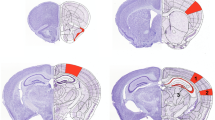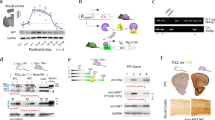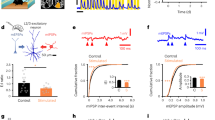Abstract
Experience-dependent maturation of neocortical circuits is required for normal sensory and cognitive abilities, which are distorted in neurodevelopmental disorders. We tested whether experience-dependent neocortical modifications require Ube3a, an E3 ubiquitin ligase whose dysregulation has been implicated in autism and Angelman syndrome. Using visual cortex as a model, we found that experience-dependent maturation of excitatory cortical circuits was severely impaired in Angelman syndrome model mice deficient in Ube3a. This developmental defect was associated with profound impairments in neocortical plasticity. Normal plasticity was preserved under conditions of sensory deprivation, but was rapidly lost by sensory experiences. The loss of neocortical plasticity is reversible, as late-onset visual deprivation restored normal synaptic plasticity. Furthermore, Ube3a-deficient mice lacked ocular dominance plasticity in vivo when challenged with monocular deprivation. We conclude that Ube3a is necessary for maintaining plasticity during experience-dependent neocortical development and suggest that the loss of neocortical plasticity contributes to deficits associated with Angelman syndrome.
This is a preview of subscription content, access via your institution
Access options
Subscribe to this journal
Receive 12 print issues and online access
$209.00 per year
only $17.42 per issue
Buy this article
- Purchase on Springer Link
- Instant access to full article PDF
Prices may be subject to local taxes which are calculated during checkout






Similar content being viewed by others
References
Clayton-Smith, J. & Laan, L. Angelman syndrome: a review of the clinical and genetic aspects. J. Med. Genet. 40, 87–95 (2003).
Jiang, Y.H. et al. Mutation of the Angelman ubiquitin ligase in mice causes increased cytoplasmic p53 and deficits of contextual learning and long-term potentiation. Neuron 21, 799–811 (1998).
Rougeulle, C., Glatt, H. & Lalande, M. The Angelman syndrome candidate gene, UBE3A/E6-AP, is imprinted in brain. Nat. Genet. 17, 14–15 (1997).
Schroer, R.J. et al. Autism and maternally derived aberrations of chromosome 15q. Am. J. Med. Genet. 76, 327–336 (1998).
Albrecht, U. et al. Imprinted expression of the murine Angelman syndrome gene, Ube3a, in hippocampal and Purkinje neurons. Nat. Genet. 17, 75–78 (1997).
Dindot, S.V., Antalffy, B.A., Bhattacharjee, M.B. & Beaudet, A.L. The Angelman syndrome ubiquitin ligase localizes to the synapse and nucleus, and maternal deficiency results in abnormal dendritic spine morphology. Hum. Mol. Genet. 17, 111–118 (2007).
Zoghbi, H.Y. Postnatal neurodevelopmental disorders: meeting at the synapse? Science 302, 826–830 (2003).
Weeber, E.J. et al. Derangements of hippocampal calcium/calmodulin-dependent protein kinase II in a mouse model for Angelman mental retardation syndrome. J. Neurosci. 23, 2634–2644 (2003).
van Woerden, G.M. et al. Rescue of neurological deficits in a mouse model for Angelman syndrome by reduction of αCaMKII inhibitory phosphorylation. Nat. Neurosci. 10, 280–282 (2007).
Yi, J.J. & Ehlers, M.D. Ubiquitin and protein turnover in synapse function. Neuron 47, 629–632 (2005).
Yi, J.J. & Ehlers, M.D. Emerging roles for ubiquitin and protein degradation in neuronal function. Pharmacol. Rev. 59, 14–39 (2007).
Walz, N.C. & Baranek, G.T. Sensory processing patterns in persons with Angelman syndrome. Am. J. Occup. Ther. 60, 472–479 (2006).
Williams, C.A. et al. Angelman syndrome 2005: updated consensus for diagnostic criteria. Am. J. Med. Genet. A. 140, 413–418 (2006).
Hensch, T.K. Critical period plasticity in local cortical circuits. Nat. Rev. Neurosci. 6, 877–888 (2005).
Fagiolini, M. et al. Separable features of visual cortical plasticity revealed by N-methyl-d-aspartate receptor 2A signaling. Proc. Natl. Acad. Sci. USA 100, 2854–2859 (2003).
Gianfranceschi, L. et al. Visual cortex is rescued from the effects of dark rearing by overexpression of BDNF. Proc. Natl. Acad. Sci. USA 100, 12486–12491 (2003).
Li, Y., Fitzpatrick, D. & White, L.E. The development of direction selectivity in ferret visual cortex requires early visual experience. Nat. Neurosci. 9, 676–681 (2006).
Wallace, W. & Bear, M.F. A morphological correlate of synaptic scaling in visual cortex. J. Neurosci. 24, 6928–6938 (2004).
Philpot, B.D., Sekhar, A.K., Shouval, H.Z. & Bear, M.F. Visual experience and deprivation bidirectionally modify the composition and function of NMDA receptors in visual cortex. Neuron 29, 157–169 (2001).
Kirkwood, A., Rioult, M.G. & Bear, M.F. Experience-dependent modification of synaptic plasticity in visual cortex. Nature 381, 526–528 (1996).
Jordan, C. & Francke, U. Ube3a expression is not altered in Mecp2 mutant mice. Hum. Mol. Genet. 15, 2210–2215 (2006).
Vu, T.H. & Hoffman, A.R. Imprinting of the Angelman syndrome gene, UBE3A, is restricted to brain. Nat. Genet. 17, 12–13 (1997).
Mullen, R.J., Buck, C.R. & Smith, A.M. NeuN, a neuronal specific nuclear protein in vertebrates. Development 116, 201–211 (1992).
Desai, N.S., Cudmore, R.H., Nelson, S.B. & Turrigiano, G.G. Critical periods for experience-dependent synaptic scaling in visual cortex. Nat. Neurosci. 5, 783–789 (2002).
Goel, A. & Lee, H.K. Persistence of experience-induced homeostatic synaptic plasticity through adulthood in superficial layers of mouse visual cortex. J. Neurosci. 27, 6692–6700 (2007).
Nimchinsky, E.A., Sabatini, B.L. & Svoboda, K. Structure and function of dendritic spines. Annu. Rev. Physiol. 64, 313–353 (2002).
Kirkwood, A., Silva, A. & Bear, M.F. Age-dependent decrease of synaptic plasticity in the neocortex of αCaMKII mutant mice. Proc. Natl. Acad. Sci. USA 94, 3380–3383 (1997).
Philpot, B.D., Cho, K.K. & Bear, M.F. Obligatory role of NR2A for metaplasticity in visual cortex. Neuron 53, 495–502 (2007).
Jiang, B., Trevino, M. & Kirkwood, A. Sequential development of long-term potentiation and depression in different layers of the mouse visual cortex. J. Neurosci. 27, 9648–9652 (2007).
He, H.Y., Hodos, W. & Quinlan, E.M. Visual deprivation reactivates rapid ocular dominance plasticity in adult visual cortex. J. Neurosci. 26, 2951–2955 (2006).
Wiesel, T.N. & Hubel, D.H. Single cell responses in striate cortex of kittens deprived of vision in one eye. J. Neurophysiol. 26, 1003–1017 (1963).
Gordon, J.A. & Stryker, M.P. Experience-dependent plasticity of binocular responses in the primary visual cortex of the mouse. J. Neurosci. 16, 3274–3286 (1996).
Crozier, R.A., Wang, Y., Liu, C.H. & Bear, M.F. Deprivation-induced synaptic depression by distinct mechanisms in different layers of mouse visual cortex. Proc. Natl. Acad. Sci. USA 104, 1383–1388 (2007).
Xia, Z. & Storm, D.R. The role of calmodulin as a signal integrator for synaptic plasticity. Nat. Rev. Neurosci. 6, 267–276 (2005).
Silva, A.J., Stevens, C., Tonegawa, S. & Wang, Y. Deficient hippocampal long-term potentiation in α-calcium-calmodulin kinase II mutant mice. Science 257, 206–211 (1992).
Frankland, P.W., O'Brien, C., Ohno, M., Kirkwood, A. & Silva, A.J. αCaMKII-dependent plasticity in the cortex is required for permanent memory. Nature 411, 309–313 (2001).
Yasuda, H., Barth, A.L., Stellwagen, D. & Malenka, R.C. A developmental switch in the signaling cascades for LTP induction. Nat. Neurosci. 6, 15–16 (2003).
Torii, N., Kamishita, T., Otsu, Y. & Tsumoto, T. An inhibitor for calcineurin, FK506, blocks induction of long-term depression in rat visual cortex. Neurosci. Lett. 185, 1–4 (1995).
Mulkey, R.M., Endo, S., Shenolikar, S. & Malenka, R.C. Involvement of a calcineurin/inhibitor-1 phosphatase cascade in hippocampal long-term depression. Nature 369, 486–488 (1994).
Fonseca, R., Vabulas, R.M., Hartl, F.U., Bonhoeffer, T. & Nagerl, U.V. A balance of protein synthesis and proteasome-dependent degradation determines the maintenance of LTP. Neuron 52, 239–245 (2006).
Colledge, M. et al. Ubiquitination regulates PSD-95 degradation and AMPA receptor surface expression. Neuron 40, 595–607 (2003).
Majdan, M. & Shatz, C.J. Effects of visual experience on activity-dependent gene regulation in cortex. Nat. Neurosci. 9, 650–659 (2006).
Tropea, D. et al. Gene expression changes and molecular pathways mediating activity-dependent plasticity in visual cortex. Nat. Neurosci. 9, 660–668 (2006).
Heynen, A.J. et al. Molecular mechanism for loss of visual cortical responsiveness following brief monocular deprivation. Nat. Neurosci. 6, 854–862 (2003).
Van Splunder, J., Stilma, J.S. & Evenhuis, H.M. Visual performance in specific syndromes associated with intellectual disability. Eur. J. Ophthalmol. 13, 566–574 (2003).
Thompson, D.A., Kriss, A., Cottrell, S. & Taylor, D. Visual evoked potential evidence of albino-like chiasmal misrouting in a patient with Angelman syndrome with no ocular features of albinism. Dev. Med. Child Neurol. 41, 633–638 (1999).
Jay, V., Becker, L.E., Chan, F.W. & Perry, T.L., Sr. Puppet-like syndrome of Angelman: a pathologic and neurochemical study. Neurology 41, 416–422 (1991).
Gatenby, J. & Beams, H. Microscopist's Vade-Mecum 11th edn. (J. & A. Churchill, London, 1950).
Acknowledgements
We thank I. Davison, S. Dudek, P. Farel, P. Manis, R. Mooney, R. Sealock, M. Zylka and members of the Philpot and Ehlers laboratories for critically reading the manuscript and for helpful discussions. We also thank R. Larsen and P. Cao of the University of North Carolina (UNC) Summer Undergraduate Research Experience Program, R. Peterson at the UNC Confocal/Multiphoton Microscopy Core Facility, and Kirk McNaughton at the UNC Histology Facility for technical help. Special thanks to W. Boyes, J. deMarchena, L. Khibnik, R. Muhammad, and M. Bear for their assistance with the VEP technique. This work was supported by a UNC dissertation completion fellowship (K.Y.), a Ruth K. Broad Biomedical Research Foundation Graduate Student Research Award (K.H.C.), a Helen Lyng White Fellowship (A.C.R.), a National Institute of Child Health and Human Development training grant (T32-HD40127, A.C.R.), US National Institutes of Health grants NS039402 and AG024492 (M.D.E.), a National Institute of Neurological Disorders and Stroke grant (NS035527, R.J.W.), a National Eye Institute grant (R01EY018323, B.D.P.), and the Angelman Syndrome Foundation and Simons Foundation (B.D.P. and M.D.E.). M.D.E. is an Investigator of the Howard Hughes Medical Institute.
Author information
Authors and Affiliations
Contributions
K.Y., B.D.P. and M.D.E. designed the study and wrote the manuscript. K.Y. conducted immunohistochemistry, Golgi impregnation, whole-cell patch-clamp and field potential experiments. T.T.R. contributed to the field potential studies and conducted VEP experiments. K.H.C. contributed to the Golgi impregnation study and conducted immunoblot experiments. A.C.R. contributed to the whole-cell patch-clamp and field potential studies. D.R.B. contributed to the field potential studies. R.P. contributed to the VEP experiments. R.J.W. directed the Golgi impregnation experiments and helped to prepare the manuscript. M.D.E. and B.D.P. supervised the study.
Corresponding authors
Ethics declarations
Competing interests
The authors declare no competing financial interests.
Supplementary information
Supplementary Text and Figures
Supplementary Figures 1–5, Supplementary Tables 1 and 2, and Supplementary Methods (PDF 4041 kb)
Rights and permissions
About this article
Cite this article
Yashiro, K., Riday, T., Condon, K. et al. Ube3a is required for experience-dependent maturation of the neocortex. Nat Neurosci 12, 777–783 (2009). https://doi.org/10.1038/nn.2327
Received:
Accepted:
Published:
Issue Date:
DOI: https://doi.org/10.1038/nn.2327
This article is cited by
-
Psychosis spectrum illnesses as disorders of prefrontal critical period plasticity
Neuropsychopharmacology (2023)
-
Imbalanced expression of cation-chloride cotransporters as a potential therapeutic target in an Angelman syndrome mouse model
Scientific Reports (2023)
-
Signalling pathways in autism spectrum disorder: mechanisms and therapeutic implications
Signal Transduction and Targeted Therapy (2022)
-
Insulin-like growth factor-2 does not improve behavioral deficits in mouse and rat models of Angelman Syndrome
Molecular Autism (2021)
-
Mono-ubiquitination of Rabphilin 3A by UBE3A serves a non-degradative function
Scientific Reports (2021)



